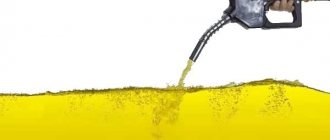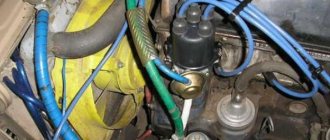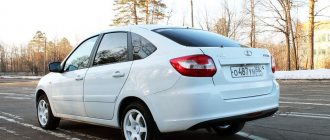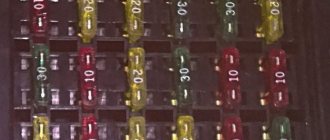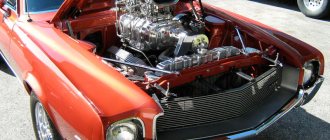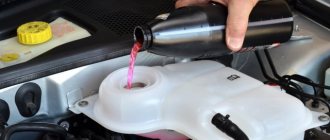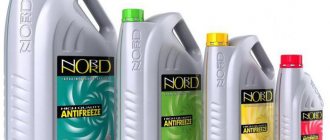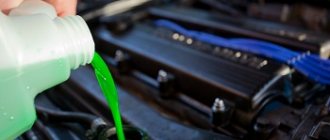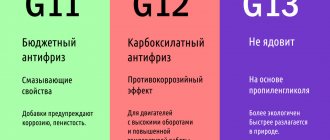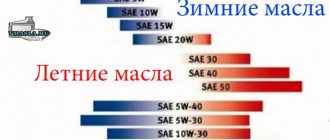Without coolant, the engine will not be able to function for more than a few tens of minutes. Therefore, in the event of a sudden antifreeze leak, you will have to replenish the minimum coolant supply in order to continue driving. But it is not always possible to choose the antifreeze recommended by the car manufacturer. Below we will try to figure out whether it is possible to mix G12 and G12+ antifreezes.
Main features and technical specifications
Coolant class G12 is the result of the long-term development of technologies for creating refrigerants based on organic acids. Today, liquids of this group are also available in improved versions G12+ and G12++. Characteristic features of the product in this category:
- At ambient temperature, the density varies from 1.065 to 1.085 g/cm3.
- The boiling point is reached at +118 °C.
- Freezing at -50 °C.
- The concentrate has a density of 1114 kg/m3.
Antifreeze "G12" has the following characteristic physical properties:
- homogeneous composition;
- noticeable viscosity and oiliness;
- in its pure form it is practically colorless;
- complete absence of mechanical precipitation and impurities.
The manufacturing process involves the addition of a coloring agent. Manufacturers are not regulated in this matter. Therefore, various bright colors are often used to simplify the process of monitoring the process fluid level. Now let's look at the main types of antifreeze of the "G 12" type.
Antifreeze - what is it?
Antifreeze is the international name for car coolants. Translated from English, the word Antifreeze means “not freezing.”
All antifreezes contain a glycol base: ethylene glycol or propylene glycol, plus a package of improving additives.
Ethylene glycol is a dihydric alcohol. Pure ethylene glycol is an oily liquid with a sweetish taste, with a boiling point of about +200 °C and a freezing point of -12.3 °C. Ethylene glycol is a strong poison. The lethal dose for humans is only 200-300 grams (by the way, it is neutralized with ethyl alcohol).
The composition of antifreeze concentrate is approximately as follows:
- 90% – ethylene glycol;
- 5-7% – additives;
- 3-5% – water.
Please note that approximately 90% of all antifreeze concentrates consist of ethylene glycol and 3-5% distilled water. That is, about 95 percent, all antifreezes are the same. It's all about the additives: these 5-7% determine whether your engine will run smoothly, or whether you will be a favorite customer of the service station.
Let's figure out what the difference is, but it won't be easy. No other liquid used in a car has such confusion as that used in the classification of antifreeze. Today there is no single standard that all antifreezes meet.
Each country produces coolants according to its own national standards, which are often very outdated. Below are the most common versions:
- GOST 28084-89 (Russia)
- BS 6580: 1992 (UK)
- SAE J 1034 (USA)
- ASTM D 3306 (USA)
- ONORM V5123 (Austria)
- AFNOR NF R15-601 (France)
- CUNA NC956 16 (Italy)
- JIS K2234 (Japan)
- G-11 (Sweden)
What to do, you ask? How to make sense of all this sea of coolants?
The antifreeze manufacturers themselves found a solution. They took as a basis the classification that the Volkswagen concern developed for itself. Volkswagen divides all antifreezes into three classes:
- G11
- G12
- G13
Let's look at everything in order.
Antifreeze G11
Antifreezes created using traditional technology are produced under the G11 class. (it is also called silicate). Inorganic substances and their various combinations are used as corrosion-protective additives in such antifreezes:
- Silicates;
- Phosphates;
- Borates;
- Nitrites;
- Amines;
- Nitrates.
The silicate additives contained in G11 antifreeze cover the entire internal surface of the cooling system with a protective layer, approximately the same as scale on the walls of a kettle. This layer protects the system from destruction. And this is good.
But it significantly reduces the heat transfer process. And that's bad. In addition, due to temperature changes and vibration, this layer begins to collapse and crumble down over time. And that's bad too. It is for this reason that you must remember to change such antifreeze at least once every two years. But that's not all either. The pieces of the protective layer that fall down are captured by the flow of coolant and begin to work like an abrasive, destroying everything in its path.
What conclusion do we draw? Do not use G11 antifreeze? No, use it! But don’t forget to change it every two years.
Antifreezes made using traditional technology (silicate) are indicated on the cans with the following inscriptions:
- G11
- Traditional coolants
- Conventional coolants
- IAT (Inorganic Acid Technology)
True, sometimes there are silicate coolants without any class designation on the packaging.
Antifreeze G12, G12+ and G12++
G12 class antifreeze is the next stage in the development of coolants. Manufacturers decided to eliminate the shortcomings of silicate technology by mastering the technology of organic acids.
Carboxylic acids are used as anti-corrosion additives in G12 antifreeze. Hence the second name for these antifreezes – carboxylate. Their distinctive feature is that carboxylate additives do not form a protective layer over the entire surface of the cooling system, but begin to work only in places where corrosion occurs, with the formation of protective layers no more than one micron thick.
All the disadvantages of silicate technology have become advantages here:
- Very high heat transfer.
- There is nothing to crumble and collapse in the cooling system, so there is simply nothing for the abrasive to appear from.
- The service life of antifreeze is increased to 3-5 years. Moreover, five years - if you washed, dried the system and filled it with ready-made antifreeze produced at the factory, and three years - if you violated something from this list and diluted the concentrate yourself.
But G12 antifreezes also have disadvantages - carboxylate additives begin to work only when corrosion processes have begun. That is, they began to “treat” only when the “disease” had already manifested itself, and did nothing to prevent it.
Carboxylate antifreezes are designated as follows:
- G12
- Carboxylate coolants
- OAT (Organic Acid Technology)
To eliminate the main drawback, coolant manufacturers took a half step back and combined silicate technology with carboxylate technology. As a result, the antifreeze class G12+ (hybrid technology) appeared.
Hybrid antifreezes contain, in addition to organic (carboxylate) additives, also inorganic ones. Europeans, for example, use silicates, Americans use nitrites, and the Japanese prefer phosphates.
G12+ antifreezes are designated by the following terms:
- Hybrid coolants
- HOAT (Hybrid Organic Acid Technology)
Since 2008, G12++ class antifreezes have appeared. This is a new type of coolant that combines an organic base with a small amount of mineral additives.
Antifreezes G12, G12+, G12++ are varieties of organic acid technology. After half a step back (towards silicate additives), technologists slowly began to move forward, playing with combinations of mineral components. This technology is called lobrid and is designated like this:
- Lobrid coolants
- SOAT coolants
Well, the crown of modern coolants is class G13.
Antifreeze G13
G13 class antifreezes appeared in 2012. They are fundamentally different from all the previous ones, because instead of a toxic ethylene glycol base, they have a harmless and environmentally friendly propylene glycol base.
Strictly speaking, this is where the differences end. From a technological point of view, G13 antifreeze is equivalent to ethylene glycol-based antifreeze G12++, and currently does not have any advantages (except for environmental friendliness).
Features of G12
For many motorists, this marking has already become familiar. This composition is distinguished by its good ability to prevent and form corrosion processes on the surfaces of parts of the car cooling system. Organic inclusions of antifreeze under the influence of chemical processes are concentrated in the zone of active oxidation. As a result, a micron protective film is formed on the affected areas. At the same time, the anti-corrosion layer does not accumulate on clean surfaces, so the composition does not help reduce the permeability of the main channels. Additionally, the composition includes components that prevent the formation of foam and scale, and also create a lubricating effect. In the production of G12 antifreeze, the following substances harmful to the power unit are not used:
- nitrites;
- silicates;
- phosphates.
The standard service life of coolant is 3–5 years. But this period can be adjusted in both directions depending on operating conditions.
The color of G12 antifreeze can be any: red, green, pink or purple. Traditionally, green is assigned to G11, and red to G12.
G13
Packaging 1.5 liters of antifreeze G13
Purple antifreeze VAG G13 is the most modern and advanced development of the concern. This is the so-called Lobrid Coolant. Like the hybrid one, it uses a combination of organic and silicate components, but in a more optimal form. This liquid has very high protective properties.
Recommended for replacement every 3-5 years. Can be mixed with predecessors with one and two pluses.
Product code: G013A8JM1.
Features of G12+
The main difference between this composition is the use of more advanced production technology. For visual identification, most manufacturers paint such antifreezes pink. The composition includes advanced corrosion inhibitors based on organic acids. Characteristics of G12+ coolant:
- the packaging is marked Organic Acid Technology or OAT;
- the composition can be mixed with all original antifreezes recommended for VAG family vehicles. Even mixing with G11 is allowed, but in this case the service life is reduced to 2 years.
- Recommended for use in cooling modern cars.
Is it possible to mix
It should be noted right away that you should not experiment with this at random. It is best to always use the class of antifreeze recommended by the manufacturer and fill it with that. Many drivers allow mixing liquids of the same color, but, as already mentioned, you cannot be guided by color alone.
Antifreezes can be mixed with each other if they belong to the same class. For example, blue and green G11, which also includes the well-known TOSOL.
Mixing different classes, say G11 with G12, needs to be done with great caution, although there may not be anything critical. A lot depends on the ratio. Different additives will affect the composition of the liquid, which will accordingly affect its properties. But the G12++ class can be mixed with G11 or G12, G12+.
The same applies to G13, which can be mixed with most other coolants, since it is essentially G12++, only safe. Antifreeze compatibility can be seen in the following figure.
Mixing antifreeze
When choosing antifreeze, you should first of all focus on the manufacturer’s recommendations specifically for your car and take into account the materials from which the engine is made. You should not experiment with the composition by mixing different categories. Color may indicate the class of liquid, but not always accurately.
Features of G12++
This is the newest and most advanced type of coolant of the J12 group. The carbosilicate composition includes not only organic inclusions, but also silicate additives. Because of this combination, antifreezes of this type are often called hybrid. They can be mixed with any G series coolants. The standard service life is 3–4 years. It should be noted that today it is almost impossible to find G12++ antifreeze on the market from well-known manufacturers. This is explained by the fact that they replaced these products with a new, more progressive type, namely G13.
Which brand of antifreeze to choose
The most rational option for choosing a coolant for a car is the technical parameters of the car, taking into account the tolerance. Each brand of car has a specific approval specification. For example:
- For a BMW car, BMW specification No. 600. 69. 0.
- For Volkswagen, the VW TL approval is 774.
- For a Ford car there is a specification FORD SSM - 97B 9102 A.
Exact data can be found in the machine’s operating manual, or from official dealers on their website.
What is included in G12 coolant?
Coolant in this category consists of the following basic components:
- Ethylene glycol (±90%) . Dihydric alcohol is the basis of the refrigerant. The boiling and freezing points depend on its concentration.
- Distilled water (±5%).
- composition ( ±5%). The package of additives includes substances that improve the physical and performance properties of the product. Manufacturers use carboxyl and phosphate compounds to protect against corrosion processes. Components are also added to eliminate foaming and scale deposits. Dyes provide easy visual identification.
Refrigerant properties
Almost 95% of all antifreezes are the same. The basis of all refrigerants is ethylene glycol (propylene glycol), which is an oily liquid with a boiling point of +2000C and a freezing point of -12.30C. To enhance the characteristics of antifreezes, various additives are added to their base. Antifreeze class g12 is called carboxylate, since it contains carboxylic acid.
It is recommended to mix coolant with refrigerants from only one manufacturer, and softened water should also be used . Coolant inherently has protective properties:
- screening of destruction;
- enhanced heat exchange;
- used in shared vehicle fleets;
- reduces OS repair costs;
- protects the environment;
- prevents foaming;
- Neutral to gas hoses and varnished surfaces.
Concentrated antifreeze consists of 90% ethylene glycol, 3% softened water and 7% various additives, the quality of which determines whether the electric motor will operate trouble-free or not.
The main differences between the G12 coolant and the points
- The composition includes organic additives that do not have a destructive effect on metal surfaces. Antifreeze G12 activates its protective properties in areas of corrosion damage, and G11 forms a film on all elements of the cooling system.
- Production is based on more complex and advanced carbosilicate technology. The compositions of the “G 11” group are created on the basis of the silicate process.
- Long service life and stability. Unlike G11, it does not create abrasive residue when its service life expires.
- Has more efficient heat transfer performance.
- Can be used in modern cars with aluminum cylinder heads and radiators.
- Increased boiling point, which creates good conditions for active vehicle operation in difficult conditions.
- The only difference from the more progressive G13 is the dangerous base, but if you take precautions, this drawback is almost completely eliminated.
G11
G11 refers to traditional or silicone antifreeze. TOSOL can also be included in this category. Various inorganic compounds act as anti-corrosion additives: nitrates, silicates, borates, phosphates and their compounds. These substances form a protective layer on the metal surface that prevents corrosion.
The service life of the liquid is on average 2-3 years. The protective layer reduces heat transfer, which affects heat transfer. Over time, the layer may crumble, leaving abrasive particles inside the system. This class of coolant is rarely used in modern engines; it is used on domestic cars with a cast iron cylinder block.
Advantages and disadvantages of G12 coolant
The advantages of the product include the following qualities:
- Provides more efficient cooling of the vehicle's power unit when compared with the compositions of the “junior” series. The increased characteristics are explained by the special composition of additives.
- The composition has improved heat transfer. This quality makes it a good option for machines that operate in difficult conditions.
- Long service life. If you follow the technology of flushing the system and replacing the coolant, then the antifreeze will not lose its quality for at least 5 years.
- Quickly eliminates pockets of corrosion and also protects weakened surfaces.
G12 coolants have only one drawback. It lies in the fact that carbosilicate additives begin to act only when areas affected by corrosion appear. Consequently, the preventive function of the composition is virtually absent. This drawback can be completely eliminated with the help of special modern auto chemical products.
Why is antifreeze painted in different colors?
Now in the world there is no clear classification according to which a certain color would characterize the chemical composition of a particular brand of coolant. However, one group of motorists argue that this feature of the fluid indicates its class and composition. Another group of experts insist that the color scheme indicates the degree of toxicity of the solution used. At the same time, both groups of specialists argue that mixing coolants of different colors is not entirely safe.
Compatibility of G12 and other antifreezes
If there is a need to mix G12 refrigerant, then you need to adhere to the following recommendations:
- It is strictly forbidden to connect with G11. This limitation is due to the radically different chemical bases of the liquids.
- You can mix compositions of different colors, provided their composition is identical.
- A combination of G12 and G12+ is allowed in any proportions. These coolants have minimal differences.
Despite these tolerances, mixing antifreeze is considered not the best option. Ideally, it is necessary to flush the cooling system and fill with one refrigerant. But in critical situations, these tips will help prevent offensive mistakes.
How to spot a fake
To avoid buying a fake by mistake, you need to know what signs will help you distinguish the original antifreeze.
- First of all, this is quality, it should be visible in everything. The plastic of the canister is dense and smooth, without defects, chips or signs of opening. The seams are even and smooth. The lid is tightly connected to the protective ring. The labels are glued smoothly, without folds, bubbles or glue drips.
- Secondly, this is information. It must be applied to the labels efficiently (without errors, not smeared, not erased) and contain the necessary minimum information about the product. This is the product code (article), date of manufacture and bottling, specifications, composition, standard, recommendations for use, address and telephone number of the manufacturer.
When purchasing, you should ask the seller to show a quality certificate - all original products have one.
You may also be interested
How to choose the right antifreeze and avoid unpleasant consequences
Antifreeze is a special liquid used to cool a car engine; its task is to maintain the optimal temperature of the engine, preventing it from overheating, and ensuring uninterrupted operation of the system. By circulating in the car's cooling system, antifreeze removes as much energy from the engine as is expended on the operation of the vehicle. It should be remembered that antifreeze is an aggressive solution consisting of […]
Antifreeze Sintec Lux OEM G12 red: description and properties
Carboxylate antifreezes are common on the market; among the company’s products, class twelfth antifreeze includes SINTEC LUX OEM G12/S12 antifreeze. This is a red liquid, which is packaged in 1 kg, 3 kg and 5 kg bottles, as well as in 10 liter and 20 liter canisters.
Antifreeze which company to choose
1. Tosol-Sintez is Russia’s largest manufacturer of motor oils and other auto chemicals. After the development of investments in the amount of 1 billion rubles in 2007, the product line expanded significantly: brake fluids and pads, glass washers and bulk mixtures, auto cosmetics and Felix antifreeze. High-quality goods are supplied to 15 neighboring countries.
2. Liqui Moly is a rapidly growing German company producing over 6 thousand products. Over more than half a century of development, it has earned credibility in the market of auto chemicals and motor oils - it is among the leaders in sales, selling products in 120 countries around the world. The manufacturer's antifreeze products are well-deservedly popular among motorists.
3. Motul is a famous French company founded in 1853 in New York. It produces lubricants for engines of industrial machines and vehicles, and works closely with automotive giants. Pays special attention to the environment - produces synthetic biodegradable products.
4. “Obninskorgsintez” is a young Russian company that produces auto lubricants, motor oils, and Sintec antifreezes. Sixteen years of hard work have yielded results - the manufacturer’s products are in demand not only in the Russian Federation, but also in the CIS countries.
Recommendations:
6 best brake fluids
7 best antifreezes
Legend
| Designations | Units | Names |
| ρ | g/cm3 | Density |
| pH | – | pH value |
| T s | ‒°C | Freezing point |
| T k | +°C | Boiling temperature |
| C | thousand ₽ | Price 1 kg (l) as of 01.2017 |
| Color | – | Color |
Is it safe to mix liquids of different colors?
There are some misconceptions among novice motorists about whether it is possible to combine antifreeze of different colors. In the automotive industry, there is a certain color scale, which was developed by specialists from the Volkswagen concern, but all manufacturers do not have to strictly adhere to it. Therefore, some manufacturers add various dyes to liquids on their own initiative.
Sometimes a situation arises that one chemical composition can have several colors and, conversely, two different liquids can be completely identical in composition. Therefore, when deciding to combine two liquids, relying only on color is a rather rash decision.
Is it possible to mix liquids of the same color from different brands?
Based on the above information, it follows that it is quite unsafe to be guided only by color before combining two substances. But during the process of using a car, situations arise when it is not possible to get the required brand of antifreeze and therefore you have to rely only on the supplies at hand.
In such a situation, you should know the following practical observations from experienced motorists:
- green color most often corresponds to class g11 and g12;
- yellow color corresponds to class g 13, but in some cases also g 12+.
Knowledge of these practical principles will reduce the risk of making an unwanted connection and causing serious problems in the future in the operation of the engine.
